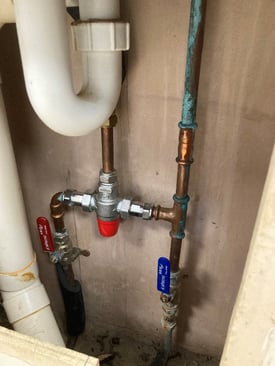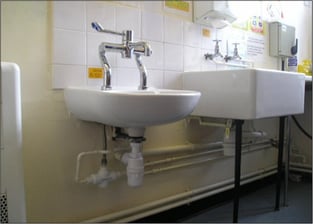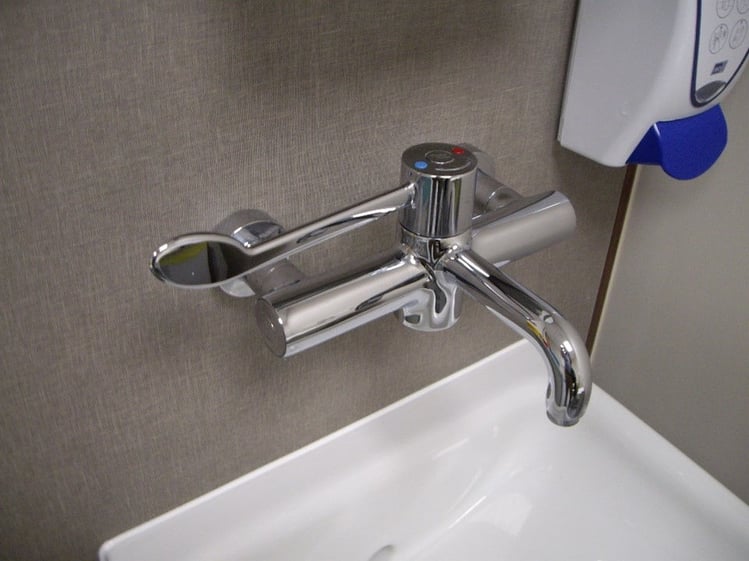One of the risks associated with water safety that require our attention is the risk of scalding.
The HSE Information Sheet HSIS6, states “If hot water used for showering or bathing is above 44°C there is increased risk of serious injury or fatality” and that a “risk assessment of the premises should be carried out to identify what controls are necessary and how the systems will be managed and maintained.” This action is regulated by the Health and Safety at Work etc Act 1974 (HSWA), section 3.
Where vulnerable people are exposed, or where there is potential for whole-body immersion, engineering controls should be provided to ensure that water hotter than 44°C is not discharged from those outlets. Such engineering controls can include thermostatic mixing valves (TMVs).
What is a TMV?
A TMV mixes hot and cold water to deliver water at a pre-set, safe temperature to reduce the risk of scalding.
Depending on your source, versions of TMVs have been used on domestic water systems for over 100 years, but keeping to the current century to avoid debate, guidance on the correct use of TMVs can be found in HSE’s ACoP L8 back in 2000. An example piece of such guidance was to ensure that the TMV should be sited as close to the outlet as possible (<2 metres), thus minimising the length of blended water that could give favourable conditions for bacteria to thrive, such as Legionella.
What is a TMT?
A thermostatic mixing tap (TMT) ensures that this length of blended water is kept as short as possible by building the TMV within the outlet body itself.
The Department of Health’s (DoH), HTM04-01: Addendum Pseudomonas aeruginosa – advice for augmented care units back in 2013 stated a “TMV that is integral to the body of the tap/shower is preferred” as it reduces the length of blended water and ensures the cold water is drawn through every time the outlet is used. It was becoming widely known that a TMT was preferred to a traditional TMV in terms of bacterial risk.
The most up-to-date guidance from the HSE (2014) and DoH (2016) continue to recommend that TMVs, where practicable, should be “incorporated directly in the tap fitting”, thus preferring a thermostatic mixing tap.
The main advantages of TMTs are;
- The length of blended water is minimised;
- The cold water supply does not represent a deadleg;
- Access to maintain and repair is easier as TMVs can be located behind panels/walls/pipework;
- They are in plain sight and less likely to be forgotten;
- Tend to be designed for healthcare premises, so materials and design are chosen with bacterial risk in mind.
But what about the difference in scald risk protection?
 It is important to note that not all mixing devices built into the tap head are thermostatically controlled. Manual mixer-style taps, as seen on a standard kitchen sink at home, are considered Type 1 mixing valves, allowing the user to manually mix the water from cold to full hot water temperature.
It is important to note that not all mixing devices built into the tap head are thermostatically controlled. Manual mixer-style taps, as seen on a standard kitchen sink at home, are considered Type 1 mixing valves, allowing the user to manually mix the water from cold to full hot water temperature.
To increase scald protection, Type 2 or Type 3 mixing valves should be considered, which both include a set temperature limit. Type 3 mixing valves have enhanced performance specifications, including a failsafe feature, which will shut off the hot water if the cold water supply fails.
Both TMVs and TMTs can be purchased with varying rated scald protection and both with TMV 3 certification, so a comparison of scald protection is “Type” dependent.
Thermostatic mixing taps are becoming increasingly common in healthcare buildings due to the advantages listed above. However, some disadvantages require consideration, these include;
- Cost – TMTs can range from £300 - £800 each, compared to a TMV that typically costs between £30 - £100 (although the purchase of an outlet (tap) is still required);
- Less familiarity - if installed in non-healthcare settings for users not used to operating them domestically;
- They typically are greater in size, so will require more space to install;
- Potential to be damaged or altered as the TMT is accessible;
- Access to rooms where TMT/outlet is installed is required, TMV’s can be cited in accessible service ducts like hotels.
 The decision to opt for a traditional remote TMV or a modern TMT will typically come down to weighing up the balance of risk and cost. Both options can be certified to Type 3, thus ensuring the same level of scald protection.
The decision to opt for a traditional remote TMV or a modern TMT will typically come down to weighing up the balance of risk and cost. Both options can be certified to Type 3, thus ensuring the same level of scald protection.
TMTs offer a lower inherent risk of bacterial growth but at a greater cost. This is why TMTs are usually found in healthcare buildings where user susceptibility requires increased protection against bacteria and infection. Ease of maintenance is also a serious consideration, as remote-style TMVs can become difficult to access and/or isolate if isolation valves are missing or ceased.
If scald risk is considered low and blended water is desired, a manual mixer (TMV 1) type tap could be recommended, where scald risk is deemed significant, the decision of TMV versus TMT needs to be informed by considering the range of factors, RISK, COST and DIFFICULTY.
Feel free to reach out if you have any questions about the issues mentioned above or if you would like to consult with one of our experts on water hygiene.
Editors note: The information shared in this blog post is accurate as of its original publication date in November 2023.
© Water Hygiene Centre 2023









